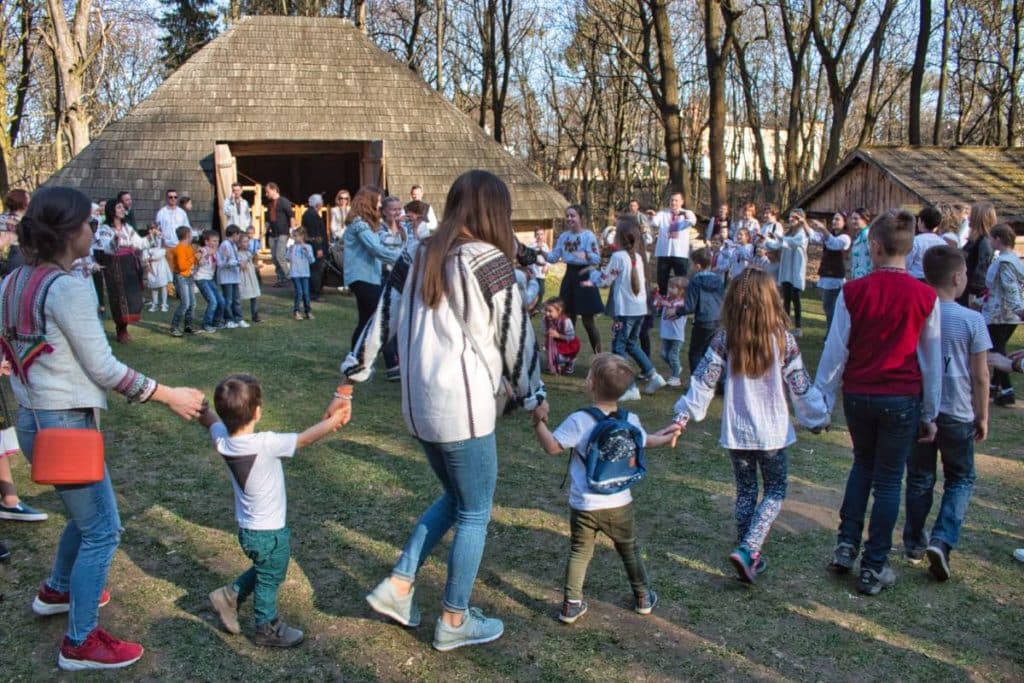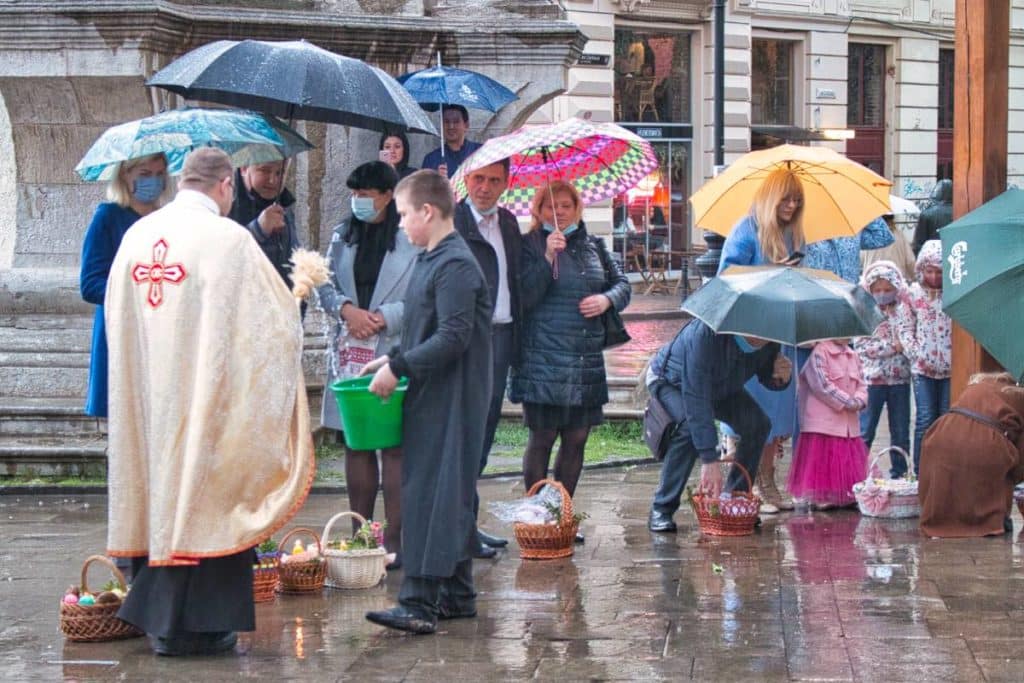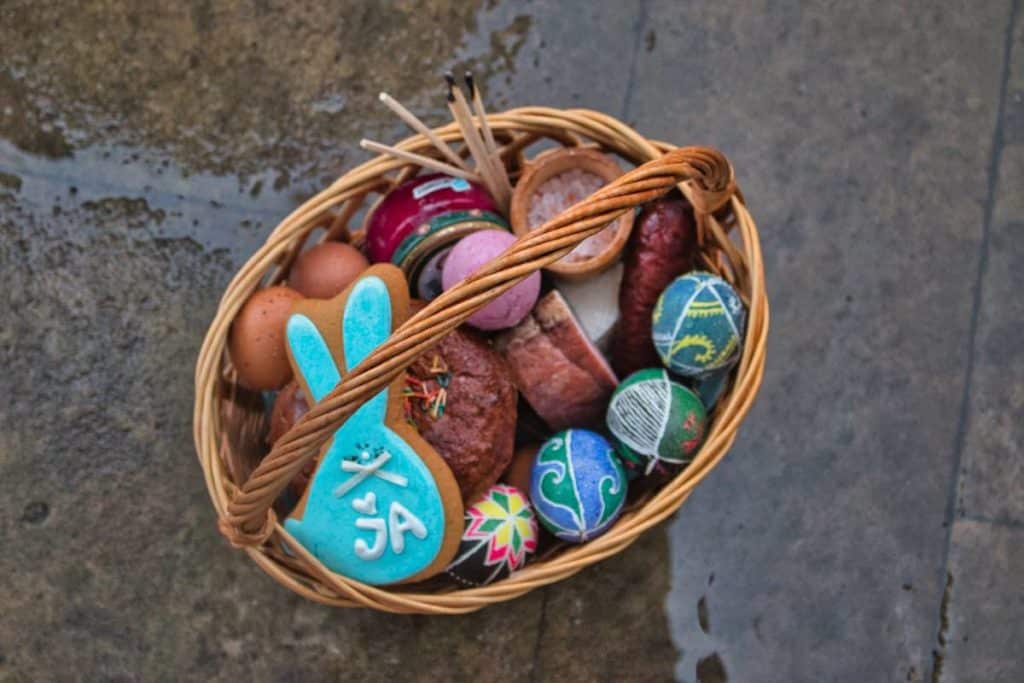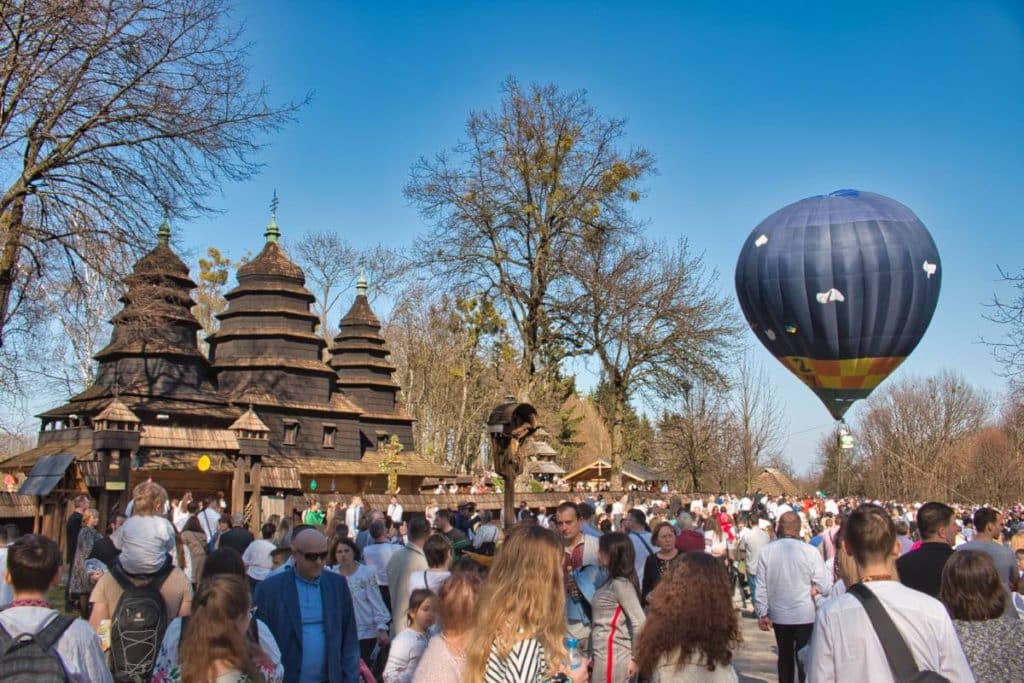Ukrainian Easter is a special time and just like Christmas it is a celebration of the whole family. Ukrainians celebrate Easter in different ways. Nevertheless, many traditions still go back to pagan times. However, many rituals also relate to the Christian meaning of the holiday, which celebrates the resurrection of Jesus. The many traditions, what you should traditionally eat on Ukrainian Easter, how to greet and where you can experience the most beautiful Easter celebrations in Ukraine, we want to explain you in this article.
Meaning of Easter in Ukraine
In Ukraine, Easter is called velykden, the “great day”. Even though this goes back to a translation of the Bible from the time of the Kyivan Rus, Easter has a special meaning, especially for religious Ukrainians. Quite a few people even consider Easter to be the most important church holiday in Ukraine. By the way, this is also something that Ukrainians share with Poles, because Easter in Poland is also an important festival there, with the same significance as Christmas.
Similar to Ukrainian Christmas, Easter in Ukraine is closely connected with pagan traditions. Pre-Christian rites combine the remembrance of the deceased, the wish for a good harvest and the beginning of the time for weddings with the singing of ritual songs and the recitation of typical greetings.

When is Easter in Ukraine celebrated?
Almost all churches in Ukraine follow the Julian calendar. This differs from the Gregorian calendar, which determines the year in most Western churches, by 13 days. Thus, most holidays simply take place 13 days later. Easter, however, is a movable holiday that usually falls on the first full moon after the equinox – when day and night last the same amount of time. This was determined at the Council of Nikea – in the year 325.
Do Roman Catholic and Orthodox Easter take place at the same time?
Due to the different calendars, the holidays sometimes fall on different weekends. In 2020, Catholic and Orthodox Easter were on the same weekend, while in 2021 they are almost a month apart. If the equinox falls on a Sunday, it is celebrated a week later, otherwise it would coincide with the Jewish Passover. The Council of Nikea had ruled this out. However, the Catholic Church as well as the other Western churches ignore this.
When will Easter be celebrated in Ukraine in the coming years?
Easter in Ukraine 2022: Sunday, April 24 Easter in Ukraine 2023: Sunday, April 16 Easter in Ukraine 2024: Sunday, May 5 Easter in Ukraine 2025: Sunday, April 20
Easter Ukraine – The holidays
Since the Easter celebrations last more than a week, there are several ways to celebrate the holiday. From more religious holidays to the days when almost all Ukrainians are on their feet, there is a whole range.
Palm Sunday / Willow Sunday
Palm Sunday also exists at the Ukrainian Easter. Here, however, it is called Willow Sunday. Of course, there are no palm trees in Ukraine, which is why Jesus’ entry into Jerusalem is commemorated with willow branches. The branches are blessed by the priest in the church both among Orthodox and Greek-Catholic Ukrainians. After that, people take the branches and gently strike their fellows. At the same time the believers say something. For example, in Western Ukraine it is: “Не я б’ю – верба б’є! Через тиждень – Великдень!” – “I do not beat, the willow beats. Easter is in a week!” However, the sayings differ depending on the region.
Pure Thursday or Clean Thursday
The Thursday before Easter is traditionally the last working day of the Easter week. On Clean Thursday, many people clean their homes and often themselves. Some go to a nearby river and wash their faces in the ice-cold water. On Maundy Thursday, Jesus is said to have eaten the Last Supper with the 12 apostles. From Good Friday on, work is actually forbidden. Therefore, a special service is still held on the evening of Pure Thursday. From here the visitors go home with candles. Especially in Eastern Ukraine Maundy Thursday is considered Easter of the dead and so it is said that on this day the ancestors meet in the church for Holy Mass.
Good Friday
In Ukraine, too, Good Friday is a day off for religious people. Unlike in many other countries, however, many stores are still open. Good Friday, however, is the strictest fasting day; after all, Jesus is said to have died on Good Friday. There is virtually no food allowed. Believers move on their knees in church on this day to imitate Jesus’ crucifixion journey and sufferings. Also, a Lenten shroud is carried around the church, which is supposed to represent Jesus’ shroud. Good Friday is also considered a special confession day. All confessions should be made up to this point.

Easter Saturday
On Easter Saturday, services are held in the churches throughout the day. An important service begins at midnight and can last until the morning hours. In western Ukraine, many people already go outside the churches on Easter Saturday and have their Easter baskets blessed with holy water by a priest.
Easter Sunday
On Easter Sunday, many believers go to the churches. The churches are bursting for morning worship. Once again, people bring their Easter baskets and have them blessed. But some also spend the whole night in the church and only go home to sleep afterwards. On the morning of Easter Sunday, usually after the service, there is an extensive feast with the food that was previously blessed in the Easter basket. After all, Lent has just ended and animal products may be consumed again.
Wet Monday
On Easter Monday, which is also known as Wet Monday, people are splashed with water in the street. Thus, water on this day especially represents purification from sins. In villages in earlier centuries, young women in particular were splashed with water to wash them clean and prepare them for a future marriage. In return, the women give Easter eggs to the men. However, whether sympathy increases when girls are doused with a bucket of water can be doubted. Some women therefore prefer to hide completely at home on Easter Monday.
In the Transcarpathian region, the ritual traditionally lasts for three days: on Easter Monday, women are splashed with water, on Tuesday they give the young men painted Easter eggs, and on Wednesday everyone splashes each other again. By the way, Ukrainians consider rain on Easter Monday as a good sign for a better year!

Ukrainian Easter as the end of Lent
Fasting is a fundamental part of Easter for religious Ukrainians. While in some countries attempts are made to culturally introduce a meat-free day during the week, in Ukraine the fast is 40 days without animal products, i.e. completely vegan. Meat, eggs and dairy products are taboo during this time – another reason why Ukrainians find Easter eggs particularly tasty afterwards. The fasting period ends on Easter Sunday. Easter Saturday is the last day of fasting before Easter. Even though the fast actually lasts 40 days, only very few Ukrainians take part in it.
After all, at least on Good Friday and Easter Saturday, many people eat meatless food in accordance with the fasting tradition and do not drink alcohol. The fast is actually broken on Easter Sunday after the return from church with the eating of the ingredients from the blessed Easter basket.
Easter traditions and customs in Ukraine
Easter in Ukraine is a time full of customs and traditions, as you could already see from the holidays. Many of these traditions have either a pre-Christian reference or refer to the resurrection of Jesus. However, there are no Easter bunnies or chocolates in Ukraine. But Ukrainians don’t need them either, because there are very nice and tasty traditions of their own.
Paska – the Easter bread in Ukraine
One of the most important parts of Easter in Ukraine is paska, Easter bread or Easter cake, depending on your point of view. It consists of an airy dough that rises and is sweet, which is then decorated. The dough usually takes quite a long time to make. During baking, according to tradition, the dough must not be disturbed, which is why there should be silence around the oven. The bread is taken out of the oven at the end of the baking time with a prayer and later often elaborately decorated.
Generally, the Easter feast is also referred to by many as Paska or Pas-cha. The term goes back to the Church Slavonic and thus to the Greek word referring to the word for the Jewish festival Passover, which commemorates the exodus of the Jews from Egypt.

Pysanky, Krashanky, Krapanky and Dryapanky – the Ukrainian Easter eggs
The other important Easter tradition you know also from the West, but in Ukraine Easter eggs belong to the national culture. They are also symbols of Christian tradition and culture of the country. Once upon a time, during the pagan spring festivals, eggs were a sign of fertility and symbolized the wish for a good harvest. The Church then transformed the meaning into a symbol of Jesus’ resurrection. In Ukraine, these two attributions combine.
There are two different varieties of Easter eggs, but both are used. Krashanky are what is known, for example, in Germany as colorful Easter eggs. They are colored and usually not painted. They are also hard boiled, while pysanky are emptied. Originally, krashanky were colored red and were supposed to represent the blood of Jesus Christ that he left for the sins of the people. Today, however, the eggs have very different colors – yellow, green or blue, for example.
However, the most famous form of Easter eggs are pysanky. The eggs, which are decorated with ornaments, are a national treasure in Ukraine. The patterns on them have various symbolisms and can represent, for example, fertility and a good harvest. Strictly speaking, the eggs are not actually painted, but decorated with colored wax. This is an ancient tradition for which there are real masters who earn their money by selling the pysanky. In the city of Kolomiya there is even an Easter egg museum in the shape of an egg, where you can see several thousand different patterns. The patterns not only represent different symbols, but can usually be assigned geographically based on the style.
Dryapanky are first dyed with a dark color. Then a pattern is painted on, which is then scratched into the egg. With Krapanky, dots are applied to raw eggs with wax. You see, Ukrainians take Easter eggs very seriously!

Easter basket
The mostly woven Easter baskets are often bulging with all kinds of food. In addition to the obilgatory paska and pysanky, Easter baskets almost always contain sausages, ham and other meats, but butter, lard, cheese and small napkins with poppy seeds, millet, salt, pepper and horseradish are also blessed. Before the blessing, a candle is lit in the basket. The baskets are usually covered with a cloth on which is written the most important Easter saying “Xrystos voskres”. After the blessing, the baskets are taken home and then the families eat whatever they contain on Sunday.
Easter greetings
A particularly beautiful tradition are the Easter greetings, which replace the normal “Good day” and thus also spread the festive mood throughout the country, reminding us of the resurrection of Jesus or even more generally of Easter.
Христос воскрес! (Khrystos voskres!) – Christ has risen!
This greeting is said from the midnight Mass, so in any case only from Sunday, not before. It recalls the resurrection of Jesus and even has a corresponding response.
Воістину воскрес! (Voyistynu voskres) – Truely he has risen!
This is the only correct response to the saying “Khrystos voskres”! Both together are traditionally said until three days after Easter. But not everyone knows this rule and sometimes it is said only on the holidays or even later. In any case, you should be prepared for it.
Other Easter greetings are used more in advance or by less religious people. These include Смачної паски! (Smachnoyi Paski – Delicious Easter Bread) or simply З Великоднем! (Ze Veliko-dnem – Happy Easter).

The most beautiful places to experience Easter in Ukraine
To experience Easter in Ukraine is simply unique. Although the holidays are celebrated more or less throughout the country, there are some regions where Easter plays a greater role and is celebrated in a particularly traditional way.
Lviv
Lviv is one of the most beautiful destinations in Ukraine to celebrate Easter. Not only are church services held everywhere, which tourists can also attend, but there are also celebrations at the Museum of Folk Architecture, to which half the city flocks. There are concerts of Ukrainian music and in the huts of the museum you can see all kinds of traditions related to Easter.

Carpathians
Of course, Easter celebrations in the Carpathians are particularly traditional. Especially in the region around Ivano-Frankivsk around the so-called “Black Mountains” is celebrated a lot and intensively. Tourists are always welcome at the local Hutsuls, but you have to ask locally about the exact celebrations. A visit to the Pysanky Museum in Kolomiya should definitely be on your itinerary.
Kyiv
There are also many celebrations in the Ukrainian capital Kyiv. Especially in front of St. Michael’s Monastery and St. Sophia’s Cathedral there are exhibitions and markets. The museums of folk architecture and customs in Pirohovo and the Cossack museum Mamayeva Sloboda host celebrations with dances and other customs that are also worth a visit.
Booktip for refugees
Many people had to flee their homeland due to the Russian attack and have now found shelter in Germany. Our colleague Markus Bingel, together with a mother who stayed with him for a while, has written a phrasebook to help Ukrainians in Germany. Not only is the grammar of the German language explained here in a simple and understandable way, but there are also several chapters that help to be able to communicate, for example, at the doctor, at school or when going to the authorities.

